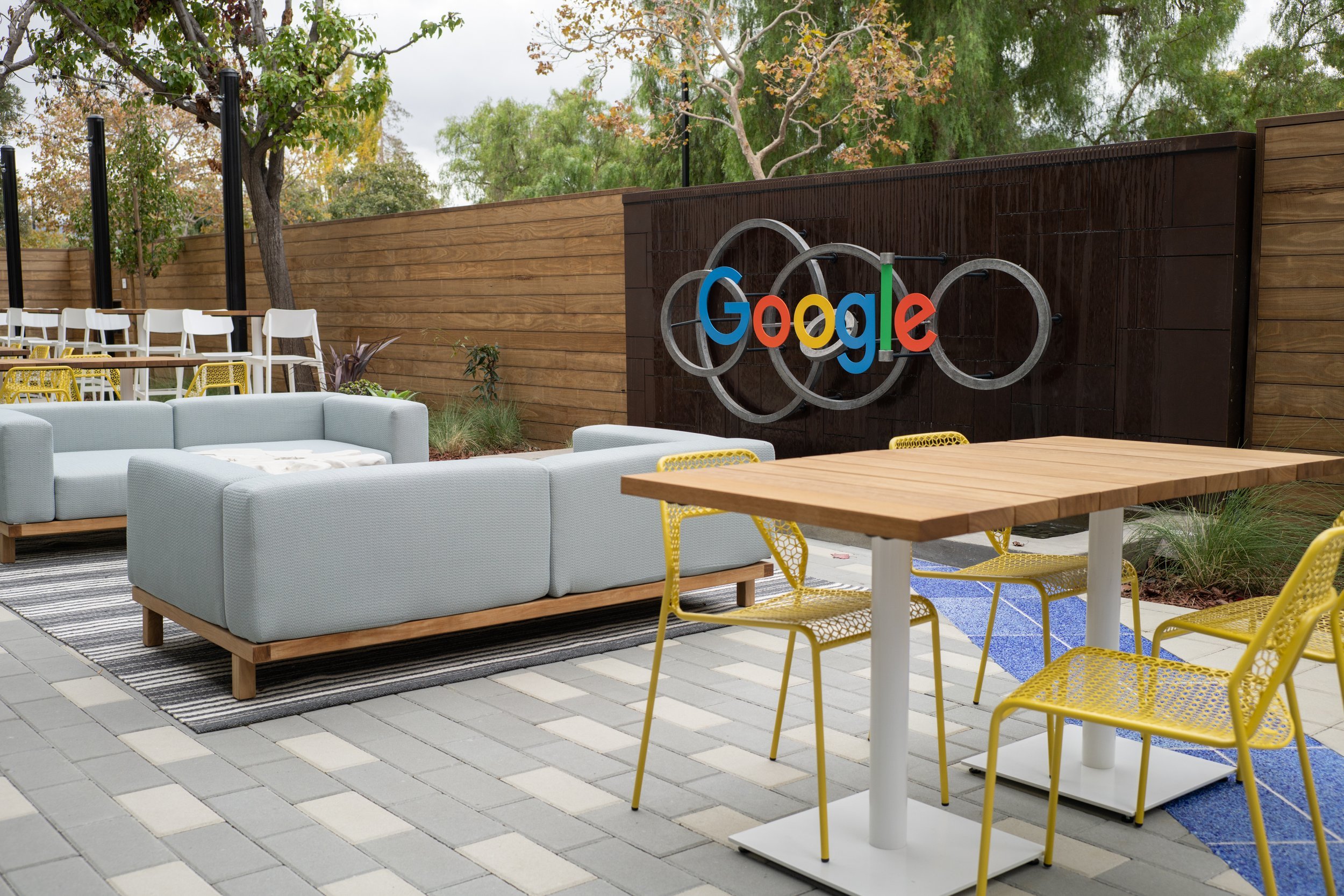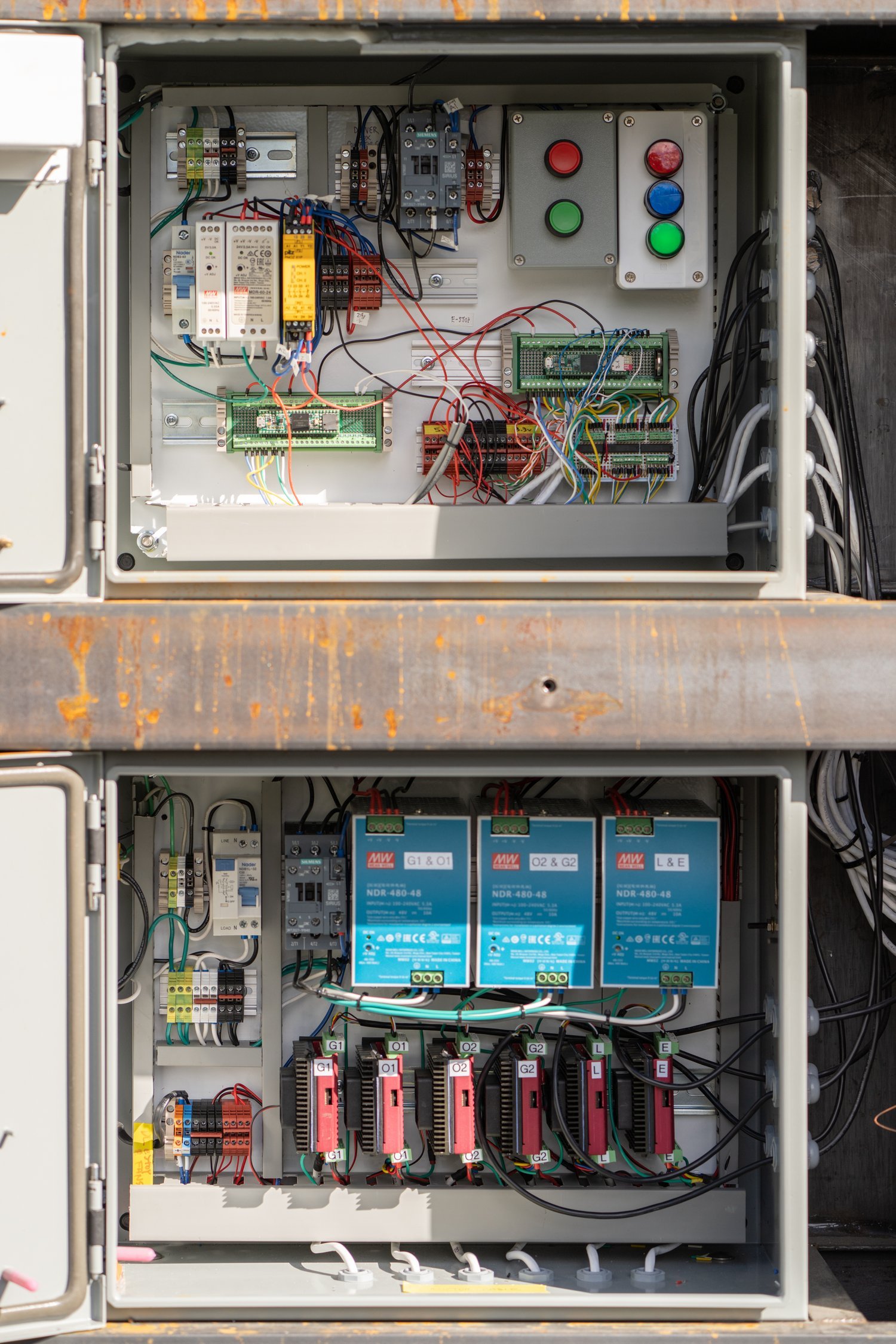This kinetic sculpture is based on the idea of an orrery, a mechanical model that depicts the movements of celestial bodies. Humans have been making these devices for thousands of years – the oldest known orrery dates back to c. 125 BCE. Early orreries relied on clockwork and hand-cut gears to drive the planets around their orbits; this one uses embedded computing and digital fabrication to illustrate the complexity and interconnectedness of the Google ecosystem.
Working with Muse & Co., I led the design and engineering of the project from sketches and moodboards through prototyping, installation, and troubleshooting. The installation is made of weathered corten steel and aluminum finished with a custom oxidation process I developed. It uses six individual stepper motors, ten custom sensors, two microcontrollers, and a constellation of supporting electronics; I wrote some 4000 lines of code for the fountain to self-calibrate, avoid collisions, manage power loss, and control its own timing.
Orrery Fountain
All six letters are coordinated, moving at relative speeds in classical harmonic ratios to each other: 1:2, 2:3, 1:3, etc. The diameter of each ring is proportional to the rotational speed.
Each ring is driven by its own dedicated stepper motor, so although the rings appear to be geared together, they spin independently. For this reason, all the letters’ movements had to be carefully calculated so as to avoid collisions.
Case Study: A kinetic, branded sculpture for Google
The brief:
My directive at Muse & Co., initially, was to design a “Rube-Goldberg-like kinetic fountain” that also prominently featured the Google logo. The project was to be situated in a courtyard behind one of the central buildings at Google’s Mountain View campus. Because the site is visible from the entrance through the open-plan layout of the first floor, part of the goal was to create a visual anchor to draw workers and visitors into the building.
Initial ideation:
At the beginning of the design process, my goal is to expand my frame of inquiry, coming up with as many ideas as possible, as different from one another as can be. This initial broadening of the field helps transform the brief – even a fairly narrowly-focused one such as this – into a more fertile ground for creativity. These initial ideas can be wild – they ranged from a courtyard-sized, water-based calculator to a waterless fountain that used sand to highlight the scarcity of water in California. We pared this initial round of maybe 20 ideas down to a handful, and brought those few into more presentable sketches. At this stage, I use CAD as a sketching tool, less as precision modeling and more as a way to communicate ideas quickly and effectively.
The winning idea:
The idea that stuck was based on the idea of a mechanical orrery, or model of the solar system, treating each letter in the Google logo as its own “planet. The reference images here are from a contemporary orrery maker (Staines & Son) and Che-Wei Wang’s incredible project 3.16 Billion Cycles. I wanted to find images here that connoted, on the one hand, the complexity and apparent magic of the clockwork mechanisms dating back to antiquity, and on the other hand the kind of precision fabrication and contemporary materials we would actually be using to fabricate something like this.
Initially, the idea was predicated on a single source of motion – like the old clockwork orreries. My thought was that this could be mechanical, the movements of the letters all geared together and driven by water.
It made sense at this point in the development to include some very minimal 3D animations – the idea itself was so dependent on motion that seeing the thing move felt essential.
Material research:
At this point, we also began to work on the material palette – what kinds of raw materials would we be using? What kinds of textures, colors, and techniques would amplify the impact of the installation? What kinds of scales and proportions made sense for the wall itself?
Iteration and refinement:
At this point, we were starting to hone in on the final design, which meant that it was also time to do the detailed design and engineering – how exactly the wall would be constructed, and how exactly the letters should move based on an initial prototype of a single ring.
I modeled the whole sculpture at the detail needed for fabrication, and used Grasshopper to simulate the motion of the letters so that I could adjust the sizes, angles, and positions of the rings precisely to avoid collisions.
Once the model was finalized, I made a series of animated simulations to show the proposed timing. It ended up being much slower in real life, once we saw the scale and presence of the real thing.
Prototyping and fabrication:
Typically, once a project moves from the design phase into fabrication, it’s out of the designer’s hands. In this case, though, the movements and necessary electronics were complex enough that I was brought back in mid-fabrication to help troubleshoot and re-engineer the “brains” of the sculpture.
A big piece of that was coming up with a scheme to retrofit a second sensor into each of the already-built rings, so that the sculpture could know with a bit more precision where each ring was (and thereby better avoid collisions). We built a full replica of the whole electronics system, and I used that to test and debug the custom electronics and code.
Alongside the electronics, I researched, tested, and refined a custom finishing process to oxidize the aluminum such that it would aesthetically complement the corten and weather gracefully in the wet, salty environment.
Install and maintenance:
Sadly, I wasn’t part of the initial install team, and don’t have documentation of that process. Which is too bad, because it involved delicately lifting and inserting the whole corten wall into place with a crane. After the physical install, I came in to wire up all the electronics, and went back regularly to troubleshoot issues, do repairs, and add functionality.







































